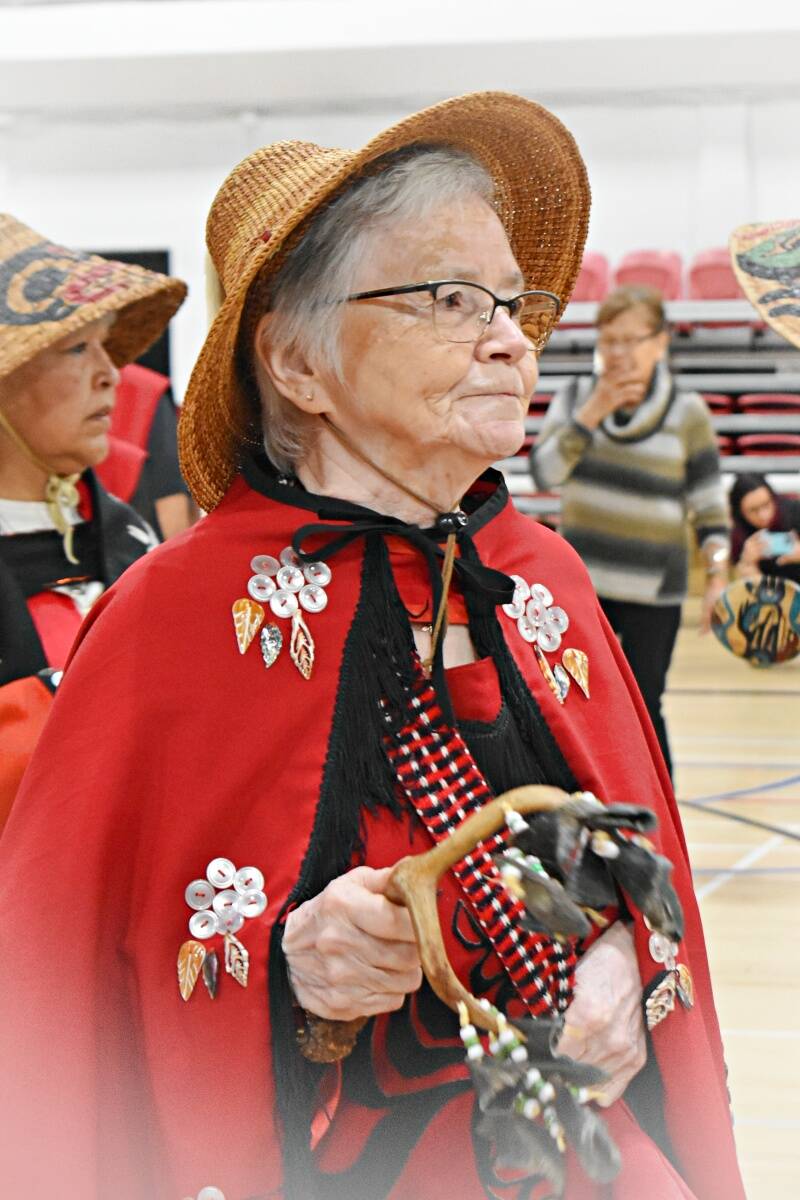“Help me, Help me. They’ve taken my children away. Oh, my poor heart. My poor broken heart, they’ve taken my children away.”
“A Mother’s Cry”, the revered song of northwestern B.C.’s Nisga’a people so effectively orates the anguish of empty-armed mothers as their children were stolen that counsellors and community supports are made available after each performance.
The song was written more than 30 years ago by Camilla Haines, a residential school survivor born into the Gitxsan nation and married into the Nisga’a Nation.
She wrote it to chronicle the heartache felt across First Nations communities as their children were taken and placed into the residential school system, where many eventually lost their way to the demons of substance abuse, alcoholism, self-harm, stolen culture and identity loss.
“The parents couldn’t do anything. So I based the song on the fact of the poor mother’s cries,” Haines said.
The solemn song starts with a heart-wrenching mother’s plea. The accompanying dance personifies priests in long black robes wrenching children from their mother’s and taking them away.
Haines said that when she wrote the song, her mother’s face was prominent in her vision.
An image cemented in her memory and clutched in the sanctum of her being is that of her mother standing on the pier, alone in silent sorrow watching a steamship carry three of her children across the water. The other parents, grieving in their own ways had left the dock, but Haines said she and her brothers stood at the ship’s railing, watching their mother watching them until they could see each other no more.
Haines was on the younger end of 12 siblings. Her older siblings had been taken to a residential school in Edmonton. She was 10 when she was taken with her brothers, 12 and 14, to a residential school in Port Alberni.
“You know, it would have been really hard on my mother because it was three of us at the same time, and then just my younger sister would have been at home with her.”
She can’t remember what she was told about going away, but she does remember the unconquerable sea-sickness that laid her flat during the entire voyage and the kindly ship’s purser who tried to help her because the person who was supposed to be “supervising” her made no effort to check-in.
She said there were many children on the steamer coming from Hazelton, the Nass Valley, Haida Gwaii, and Lax Kw’alaams.
“What they did back in those days, the government threatened … they threatened [parents] that if they ever needed help they wouldn’t help them at all … Some of them, they even threatened they would throw them in jail if they didn’t let their kids go,” she said.
“Parents just accepted the way things were.”
Not everyone was treated or abused equally at the Port Alberni school. She doesn’t know why. Maybe it was because she had already been in Indian Day school for four years and knew English.
“I myself didn’t suffer the abuses that some did. But I knew of a girl getting abused. There wasn’t anything we could do about it.”
She was allowed home for the summers where she looked after younger children while their parents worked.
When she was 17 and realized she was not going to graduate, she approached the principal with the idea of attending secretarial school. He assisted, and she moved to a girls’ group home in Vancouver. Soon after, she married a Nisga’a man and they eventually returned to the north.
Moving to the city is what many residential school survivors did, she said because they had lost any connection with their culture. This exodus is described in “A Mother’s Cry.”
While a literal translation of the song written in Nisga’a is difficult, Cam explained some of the lyrics.
“Come with me, Come with me to see my grandfather. Come with me. Come with me to see my grandmother,” relates to the children relearning the traditions and taking the stolen culture back.
“We will be OK. We will find them. We will bring them home,” speaks to parents and elders journeying to the cities to find the lost.
The final crescendo of the song celebrates how the lost have been found, returned to their families and are entwining themselves in their lineage and heritage.
Cam wrote the song while she held a position on the Anglican Council for Indigenous People (AICP) in the late ‘80s.
“I’d hear all the horror stories from people all around Canada and what they went through. It would just affect me hearing all this. So finally, one year I said I have to write a song about this.”
She took the song to her husband’s aunt and uncle who were fluent in Nisga’a and assisted with translation. The song has been held in such solemn esteem it was deemed “sacred” and only Gitmaxmak’ay Nisga’a Society dancers were granted permission to perform it.
Photographing or videoing any performance was strictly prohibited until recently. Cam said she made the change to assist with the truth and bring reconciliation.
“At first the people in the Nass hated it because it brought so much … emotion back to them. But then they accepted it. Now there are villages that have dance groups, and they’ve done similar things because it’s all a part of our history.”
She said all songs fade away eventually, and it’s now up to the second and third generations to keep it alive.
“I’ve always told them that this is part of our history. You know, it’s emotional, but it happened. So, the story still needs to be told.”
K-J Millar | Editor and Multimedia Journalist
Send K-J email
Like the The Northern View on Facebook
Follow us on Twitter

